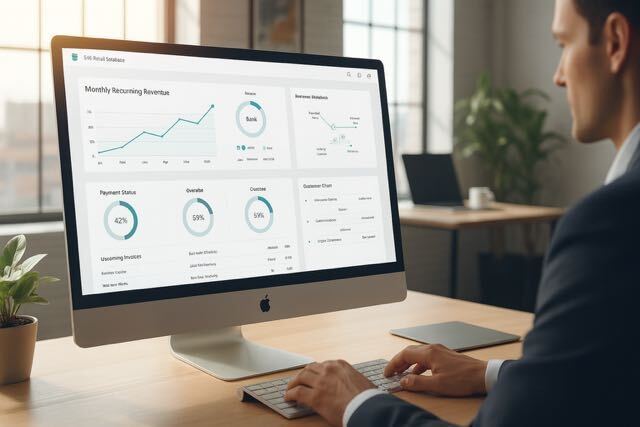4 Sales Challenges MSPs Must Overcome to Grow MRR

As a technology service provider, you’re constantly faced with a never-ending list of business challenges. The most difficult one can be increasing monthly recurring revenue (MRR). Many service providers struggle to increase their MRR because they don’t have a clear sales strategy in place.
In this blog post, you learn about the most common sales challenges service providers face when it comes to increasing MRR. By reading through our tips and advice on overcoming these issues, you can adopt the strategies that work for your business to gain more MRR over time.
Before we move forward with talking about those sales challenges, let’s look at what MRR is.
What Is Monthly Recurring Revenue
Monthly recurring revenue is a metric that measures the amount of money a company earns from monthly subscriptions to its products and services. This number can help determine a company’s success and is essential for understanding whether it can survive without any long-term projects.
MRR has many benefits for companies:
- You can focus on both short-term and long-term business goals. MRR is important for making accurate sales projections and planning for short-term and long-term business growth. You can foresee the next month’s revenue and determine what changes you require to make in your sales efforts to increase revenue by analyzing your monthly financial performance.
- You get a predictable source of income. For many businesses, especially startups and small-to-medium-sized companies, having predictable revenue is crucial for survival. Many entrepreneurs are forced to take out loans or seek investors to keep their business afloat when they don’t know when they’ll receive their next paycheck. MRR gives businesses the ability to plan for their future and reduce financial risk.
- You get a reliable source of income. MRR provides steady income every month without relying on one-time or long-term projects. Even if you don't land new projects regularly, your business still receives an income each month.
MRR is something many companies strive for. It gives them the ability to hire more employees and grow their overall customer base through hiring sales representatives or support specialists. This growth can lead to even higher revenues in the long run if the company can maintain and grow its customer base.
Now let’s move on to the four most common sales challenges service providers face when increasing their MRR.
Challenge 1: Getting New Customers
Prospecting for new leads can be a time-consuming and challenging process, especially if you don’t have a solid lead generation strategy in place. Fortunately, there are many ways to find new customers. It’s essential to tailor your approach to your business.
Common methods of prospecting for new leads include:
- Paid advertising: Paid promotion includes online advertising such as Google AdWords, LinkedIn Ads, and Facebook Ads. It also includes offline advertising such as print ads and direct mail.
- Cold calling: The practice of reaching out to potential customers who don’t know about your product or service and convincing them to become customers.
- Networking: Meeting people in person or online and building relationships with them so they’re more likely to buy from you when the opportunity arises.
- Referral programs: Offers to customers to earn a commission or other incentive to refer their friends and family members to your product or service.
Challenge 2: Building Effective Pricing Models
One sales challenge that many service providers face is building effective pricing models. This task can be daunting because it requires knowledge of your customers and their needs. It also requires an understanding of the value you’re offering them in exchange for payment.
While there are several ways to set your prices, here are some standard methods:
- Per-user fees: Charge a certain amount of money for each service user.
- Per-device fees: Charge a certain amount of money per device that uses your service.
- All you can eat: Charge a flat monthly fee for unlimited use of your product or service, regardless of the number of users or devices you support.
Regardless of the method you choose, make sure you have a system, like Goolash from Zomentum, to audit accounts on a monthly basis to ensure client billing matches any expenses you incur from your vendors.
Challenge 3: Helping Prospects With Legacy Systems
Many companies still run on outdated technology. Or they might manage entire business processes, such as accounting, manually rather than using software to complete them more efficiently and accurately.
One of the best ways to overcome this sales challenge is to build relationships with these prospects before you even try to sell them your product or service. Show them you understand their business and the challenges they face. Be prepared to offer a solution that will make their life easier.
Once you establish a relationship with them, pitch your product or service. Instead of talking about its features, focus on improving their business process and saving time.
Challenge 4: Handling Repetitive Tasks Without Automation
Another challenge service providers face when increasing MRR is handling repetitive tasks without automation. Automation involves using software that manages various business functions or processes. You can use it for everything from billing clients to sending invoices and creating quotes for prospective customers.
While you can use many different applications to automate your business, finding the right ones for your needs is crucial. For example, you can use:
- A customer relationship management (CRM) platform to manage customer relationships.
- Professional services automation (PSA) software to manage finances and operations.
- A marketing automation system to create and track marketing campaigns.
Zomentum is a revenue management platform that helps service providers increase MRR by tying their various systems together. With Zomentum, you can automate billing reconciliation, quoting, and order management tasks. This single platform saves you time and enables you to focus on more critical tasks, like selling your services.
Tackle the Challenges and Grow Your MRR
Now that you understand these four sales challenges, it's time to get to work and overcome them. With a little effort, you can increase your MRR and take your business to the next level.





.png)









